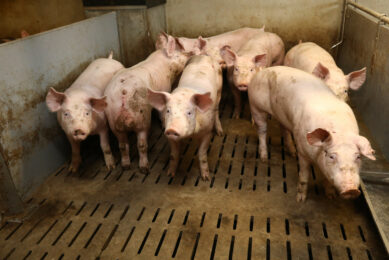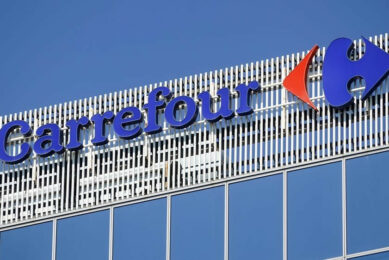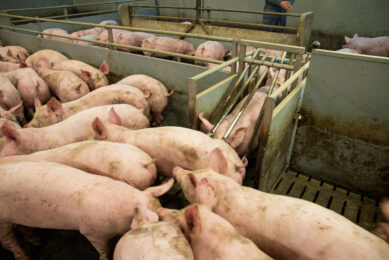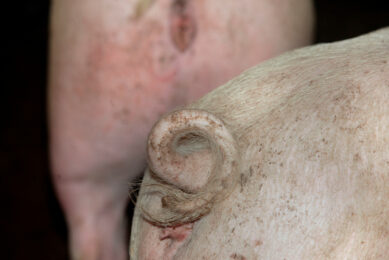Manure surplus solved by selling it
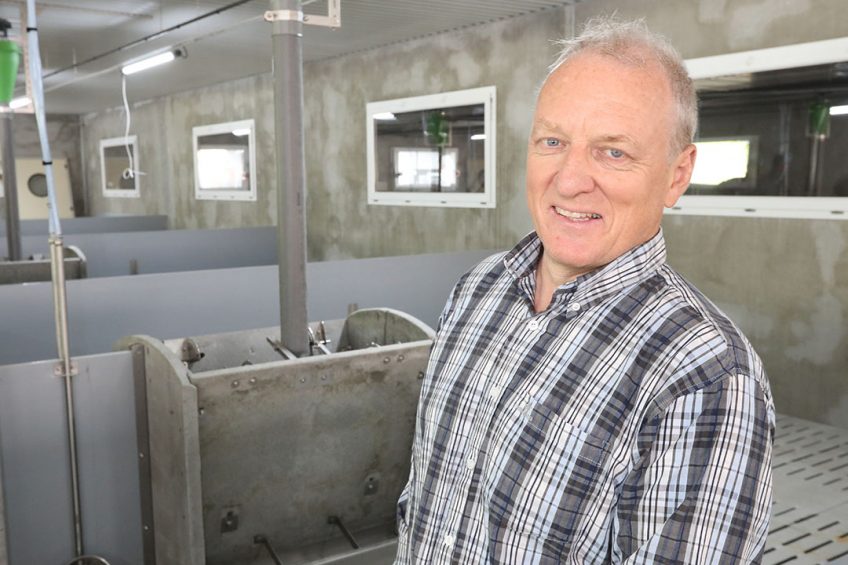
French swine farmer Bernard Rouxel joined the initiative of French pig cooperative Cooperl to start with a new plan to valorise manure in an innovative manner. The cooperative intercepts and separates manure right at the source and processes it all centrally in a new factory.
At first glance, the new finisher house design of Bernard Rouxel appears to be similar to any other pig house in Brittany, France. The facility comes with a wide central aisle with on both sides fully slatted pens. In addition, the pig house has a low ceiling construction, plastic pen walls and concrete walls between the compartments. There’s a lot of light for the pigs through the side windows, in the central aisle the light comes in through the roof. Mr Rouxel says that is all done on purpose as he likes working in plenty of daylight.
PROFILE  Bernard Rouxel, age 52, owns a closed 600 sow farrow-to-finish facility in Plénée-Jugon, Britanny, France. Annually he produces 15,000 weaner pigs. These piglets will be finished on 3 locations, an existing pig house with a 2,000 pig capacity, another on a different location with a capacity for 1,400 finishers and a third, new pig house for 2,160 finishers having manure separation on-site. Mr Rouxel is vice-president of the board at the French pig cooperative Cooperl Arc Atlantique, headquartered in Lamballe Bernard Rouxel, age 52, owns a closed 600 sow farrow-to-finish facility in Plénée-Jugon, Britanny, France. Annually he produces 15,000 weaner pigs. These piglets will be finished on 3 locations, an existing pig house with a 2,000 pig capacity, another on a different location with a capacity for 1,400 finishers and a third, new pig house for 2,160 finishers having manure separation on-site. Mr Rouxel is vice-president of the board at the French pig cooperative Cooperl Arc Atlantique, headquartered in Lamballe |
The most interesting about this facility can be found underneath the floor. Using cutting edge manure pit design, a construction called ‘Trac’ technology was built where urine and the manures thick fraction are immediately separated and stored in different places. In addition – also happening subterraneous – fresh air is constantly being sent into the compartments using air channels, while pungent air is actively being extracted from the pits. In short, manure removal and air ventilation are parts of the same, integrated pig house design.
The pig house was designed by French pig cooperation Cooperl Arc Atlantique, where Mr Rouxel happens to be vice president of the board. The choice for this design has mainly been driven by the fact that he believes in the concept of separated interception of the pigs’ urine and solid manure. Mr Rouxel would like to sell the manure. He explains, “For the solid manure, I can obtain € 20 per tonne from now on. For the next 12 years, I have a purchasing agreement with Cooperl. After on-site biological treatment of urine, 30 ha of arable land is sufficient for the application of the thin fraction of the 2,160 finishers populating this pig house.”
Gravity and movement
In order to separately intercept both solid and liquid manure, the system makes clever use of gravity and manure slides. About 50 cm underneath the slatted floors, there are prefab concrete elements in a V shape. These have a slope of 8%, allowing the urine to be diverted into a central channel. In turn, the channel has a slope of 1%, in the direction of the sides of the building. That is where the urine from all compartments on that side of the building flow together and are jointly directed towards a central storage location. To make sure that the concrete does not absorb the urine, a special concrete mixture is used.
The solid manure, however, will stay put on the prefab floor. Manure slides will pull these to an area underneath the central corridor, where the solid manure from all six compartments will be collected. Another manure slide will pull all solid manure outside. Once outside, it is stored under cover having 27-28% dry matter. This larger slide operates five times per day – it doesn’t operate during the night to allow the pigs to get through the night undisturbed.
As indicated, ventilation is also taking place underground, in a horseshoe-shaped system. Fresh air is entering the building at a central location. Once inside, the fresh air is being diverted through two channels underneath the pig house, these form the two legs of the ‘horseshoe’. In between, there is a different channel – diverting pungent air towards the exit. Using this design, heat exchange is possible, where outgoing air warms incoming air before it reaches the pigs.
The ventilation system works using lower relative air pressure. Just like the incoming air has a fixed place to enter the building, the outgoing air leaves the building at a central location. Using centrally controlled valves, the volume of air flowing through a compartment is being regulated.
Higher building costs
It does not come as a surprise that building costs of this pig house are higher than in a regular pig house with conventional manure pits below the slats. The elaborate system of channels underneath plus the in total 13 manure slides will push the price up. Mr Rouxel estimates this to be € 600 per pig place. That amount does, however come with manure storage, pavement and a new feed preparation area for the entire farm as well as a large area for pigs that will be transported. That area even comes with feeding equipment. That will allow employees to prepare pigs for transport on e.g. the Monday, with the animals effectively being picked up on the Friday.
Cooperl calculated that building costs of a similar structure as Mr Rouxel’s farm will be € 570 per pig place. A farmer will receive € 45 per pig place in funding from Cooperl and the pig producer will receive € 20 per tonne of the manures thick fraction for a period of 12 years. This thick fraction will be further processed in a biodigester to produce biomethane. For pig producers, annual costs of this pig farm with ‘Trac’ technology will be similar to conventional pig farms with manure pits underneath.
In addition, the system halves ammonia emissions. Dealing with ammonia at the source will lead to better pig performance. In Cooperl research, feed conversion has been observed to drop by 0.2%, which saves about 17kg of feed per finisher pig, between 30 and 115kg. In addition, mortality will drop 1% and health costs also reduce. For a closed farm having 1,000 sows, Cooperl estimates the health and growth advantage to be over € 200,000 per year.
In total, the new pig house will have a capacity of 2,160 pigs and will replace a number of rental facilities with altogether a capacity of 2,000 pigs. The first pigs will enter by June 10, Mr Rouxel explains. That is when the first manure slides will start to operate. Annually, 600 tonnes of thick manure will be transported to Cooperl for fermentation and processing into fertiliser. The 2,200 m3 of urine will be processed on-farm and then applied on the farm’s own fields.
Pig manure as a gold mine This autumn, French pig cooperative Cooperl will make the next step in further valorisation of pig manure. In Lamballe, the cooperative is about to finalise the construction of a large digester facility. That factory will be able to digest 38,000 tonnes of solid pig manure annually. The digester will start to operate this autumn. The facility will be among the largest of its kind in Europe. Apart from specific manure products, the digester shall also produce 7.5 million m3 of natural gas, sufficient to supply 3,200 homes. Figure 1- Digestate converted into fertiliser and pure water.  The digester will be ‘fed’ by the solid fraction from pig manure as well as fat products coming from the neighbouring Cooperl pig slaughterhouse. The manures solid fraction will come from companies working with the Trac technology. There are currently 62 pig producers working with the Trac system. Annually, they will yield 20,000 tonnes of pig manure together, with roughly 26-30% dry matter content. That volume is growing fast, as when building new finishing pig facilities, 57% of the pig entrepreneurs opts to include Cooperl’s Trac system. Cooperl estimates that by 2022 there will be sufficient amounts of Trac users to be able to pick up 38,000 tonnes of solid manure in total per year. For a guaranteed period of 12 years, pig producers will earn at least € 20 per tonne for the solid part of their manure. After the digestion process, the digestate will be processed to become organic fertiliser products in 150 different varieties. It comes as pelletised product having a dry matter content of 90%. The processing will start with the pressing of the digestate to remove even more liquid substances. After that, another set of steps will follow until the product has been dried and been made hygienic. For the drying process, the factory uses bone meal of animal origin, both obtained from its own slaughterhouse as well as from third parties, which for whichever reason is not suitable for use in pet food. As such, no fossil fuels are necessary to create the pellets. Click on the pdf attachment below to see an enlarged version of the figure. |









